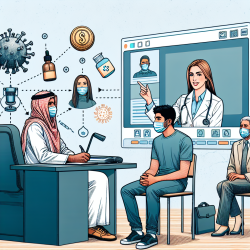Unlocking the Potential of Virtual Patients in Primary Care
In the ever-evolving field of healthcare, staying updated with the latest tools and techniques is crucial for practitioners. One such innovative tool is the Virtual Patient (VP) system, which has shown significant promise in enhancing the skills of primary care professionals. A recent study titled "Educational potential of a virtual patient system for caring for traumatized patients in primary care" explores the effectiveness of VPs in training healthcare providers to care for traumatized refugee patients.
What Are Virtual Patients?
Virtual Patients are interactive computer simulations that mimic real-life patient encounters. They provide a platform for healthcare professionals to practice and refine their clinical skills, including history taking, physical examinations, and developing treatment plans. The VP system is designed to create realistic and engaging scenarios, allowing practitioners to interact with patients in a controlled environment.
Key Findings from the Study
The study evaluated the use of a VP system in training primary care professionals at the Lynn Community Health Centre in Massachusetts. The participants, consisting of 11 clinicians, engaged with a virtual patient portraying a Bosnian refugee with a trauma history. Here are some key findings:
- Enhanced Clinical Skills: Participants reported an improvement in their mental status examination skills after the simulation exercise.
- Increased Motivation: The VP system was perceived as a valuable educational tool, with participants expressing a high motivation to use it for training.
- Realistic and Engaging: The VP scenarios were considered realistic, helping practitioners better understand the complexities of trauma care.
Why Should Practitioners Consider Using VPs?
Virtual Patients offer several advantages for healthcare training:
- Safe Learning Environment: VPs provide a risk-free platform for practitioners to hone their skills without the fear of harming real patients.
- Flexible and Accessible: The system can be accessed online, making it convenient for practitioners to engage in training at their own pace.
- Feedback and Improvement: The VP system offers automated feedback, allowing practitioners to learn from their interactions and improve their clinical reasoning.
Encouraging Further Research
While the study highlights the potential of VPs in enhancing clinical skills, it also opens avenues for further research. Practitioners are encouraged to explore the use of VPs in different clinical settings and with diverse patient populations. Understanding the impact of VPs on long-term clinical outcomes can provide valuable insights into their effectiveness as a training tool.
Conclusion
The integration of Virtual Patients into healthcare training represents a significant step forward in medical education. By offering a realistic and engaging learning experience, VPs can help practitioners improve their skills and provide better care for traumatized patients. As we continue to explore the potential of this innovative tool, it is essential for practitioners to stay informed and consider incorporating VPs into their training regimen.
To read the original research paper, please follow this link: Educational potential of a virtual patient system for caring for traumatized patients in primary care.










